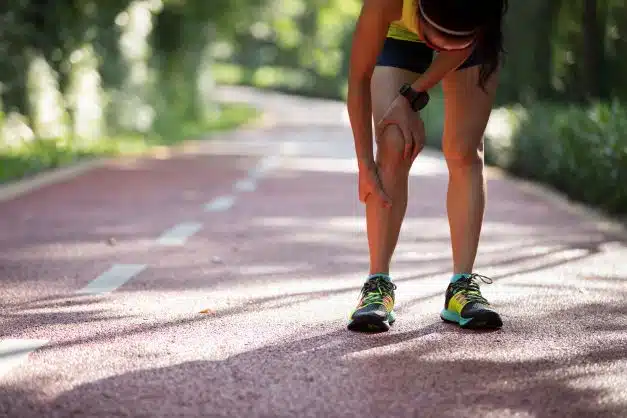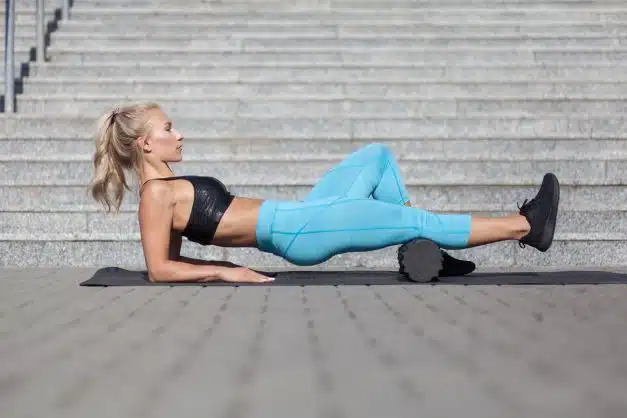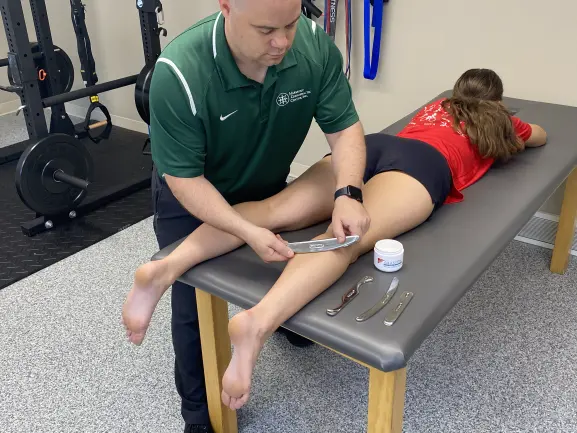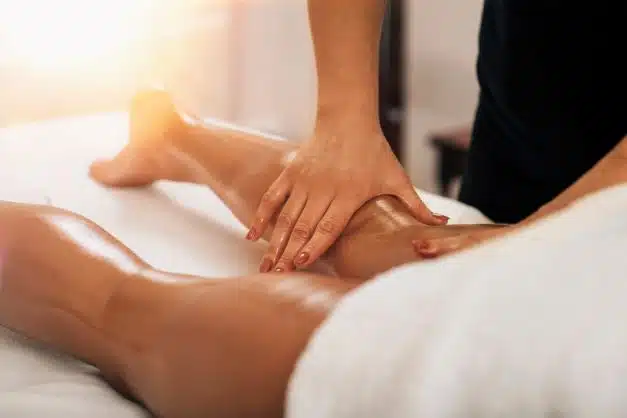Calf strains are a common problem. Any sudden movement can stretch the calf muscle well over its limit, making it difficult to run, dance, or play sports. Calf muscle strains are a type of injury that involves complete tearing or mild overstretching of the muscle. Mild problems tend to dissipate with elevation, rest, compression, and ice treatment. But, a more serious injury might require medical attention.
What is a strain?
Strains are injuries to tendons or muscles. A calf strain or pulled calf muscle happens when you overstretch the gastrocnemius and soleus (muscles in the calf). These muscles are capable of bending and flexing the foot, knee, and ankle. (1)
The gastrocnemius is prone to strains because it crosses two joints – the ankle and the knee. Plus, it has a high density of fast twitch muscle fibers, so any forceful rapid contraction or excessive stretch can cause strain. (2)

What Does Calf Strain Feel Like?
When you overstretch the muscles, small micro tears develop in the muscle fibers. The impact of these tears varies based on the suddenness and depth of the actual stretch. There are different stages of calf strains.
These include:
- Grade 1 Calf Strain: This is a mild injury that causes some discomfort. Less than 5% of the fibers have been damaged, which leads to minimal loss of motion and strength.
- Grade 2 Calf Strain: This is a moderate type of injury that could lead to severe pain. More fibers are involved and the damage is more extensive. It leads to notable loss of motion and strength.
- Grade 3 Calf Strain: This is a complete rupture of the tendon or muscle. The patient might need surgery to curb the calf strain symptoms. (3)
When you have a calf strain, you can find it difficult to tense the muscles, stand on the toes, or flex the ankle due to muscle pain. There could be some bruising or swelling in the affected area. After injuring the leg, you can feel a popping or snapping sensation in the calf muscle.
Calf Strain Causes
The calf muscle is easy to damage. Especially for people older than 40. As well as those who are active athletes, and don’t do regular warm-ups before exercise. Some of the most classic causes of calf strains include:
- Overstretching
- Abrupt movement
- Quick jumps or pivots
- Sudden stops
- Overtraining

Other Causes of Calf Pain
When the foot lands during exercise, the arch will compress to absorb that shock. If you are wearing inadequate footwear, like too-tight shoes, or shoes not meant for running, then the arch lands in an improper way.
The impact gets redistributed to the calf, which eventually causes micro-fractures. This could lead to calf strain and pain. Those who already have a weakened calf muscle, decreased range of motion, or limited mobility might be prone to strains and pains.
Multiple medical problems can cause muscle weakness and pains, including chronic illnesses, infections, conditions, and neurological complications. Be sure to talk to a specialist if the calf pain is getting in the way of your daily life.
Difference Between Calf Strain and Blood Clot
A muscle strain often appears as acute pain, and trying to stretch that muscle can cause more pain. If you have a mild strain, you can still walk but can feel notable discomfort. The symptoms of a blood clot can feel similar to a calf strain. A blood clot in the leg can trigger tenderness, warmth, and pain in the affected area. Swollen veins are sore and hard to the touch.
Then there is DOMS (Delayed Onset Muscle Soreness). DOMS often develops in the next couple of days after extensive exercise. While a calf strain can usually occur at the exact time when you hurt the calf muscle.
How To Fix Calf Strain
The best way to fix the discomfort is to try the following options. Remember that gone are the days of RICE. MEAT is now the way to go (or one of the many other acronyms) that you can use:

M: Movement is one of the keys to decreasing muscle pain and preventing long-term issues. These would be pain-free movements throughout the muscle’s range of motion. Pointing and lifting the toes and even writing your ABCs in big letters with the tip of your big toe moving your ankle can be helpful.
E: Exercise would be light resistance exercises through the range of motion when tolerated. Make the movements harder and longer over time to improve your strength and endurance. Speed your recovery by other stabilization exercises involving balance.
A: Analgesics are for controlling the pain. Naturally controlling inflammation using fish oil, ginger, turmeric is preferable in many situations. Options can also include OTC pain medications or rarely, something stronger. Using ice is also a possibility, but you wouldn’t want to use it more than a couple days post-injury. Just remember there are no medals for suffering from a calf strain.
T: Treatments for a calf strain may include kinesio taping, cold laser therapy, massage therapy, myofascial release (Graston Technique or Cupping Therapy), joint mobilization, chiropractic adjustments or electric muscle stimulation

Calf Strain Treatment
The average calf strain recovery time is 3 days. The bigger the damage, the longer it can take to heal, sometimes the recovery can last several weeks.

How To Avoid Calf Strain
Want to keep your calf muscle in excellent shape? The tips below can help:
- Rest and recuperate between exercising.
- Do routine stretches.
- Pay attention to your technique and form when working out.
- Don’t push yourself too hard.

In many cases, the calf is strained from being pushed too hard and too fast, like an inexperienced runner trying to run fast. Often, there is a lack of strength or tendency to fatigue in the calf that needs to be remedied. Lifting weights can be helpful but doing bodyweight calf raises would be effective for this issue as well. Depending on where you might be in recovery, one might do calf raise on both feet or one foot. Practice holding your contraction for time at the top of the calf raise. I will also have some people start skipping rope to build calf strength. Jumping rope is a fantastic exercise for developing calf strength and getting a great workout.
References
- Cleveland Clinic. Pulled Calf Muscle. Unites States; 2021. Retrieved from: https://my.clevelandclinic.org/health/diseases/21558-pulled-calf-muscle
- J. Bryan Dixon. Gastrocnemius vs. soleus strain: how to differentiate and deal with calf muscle injuries. Current Reviews Musculoskeletal Medicine: National Library of Medicine; 2009. Retrieved from: https://www.ncbi.nlm.nih.gov/pmc/articles/PMC2697334/
- Lawrence V. Gulotta. Muscle Strain: Causes, Symptoms, Treatment: Hospital for Special Surgery; 2019. Retrieved from: https://www.hss.edu/conditions_muscle-strain.asp
- Lauren Jarmusz. How to treat, identify, and recover from a pulled calf muscle: Medical News Today; 2021. Retrieved from: https://www.medicalnewstoday.com/articles/326431
